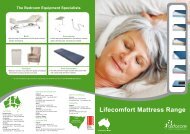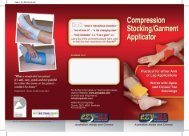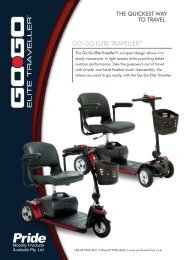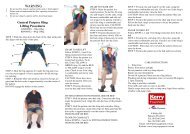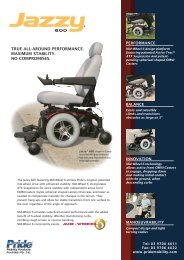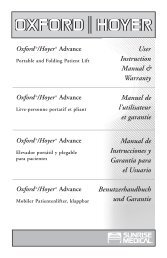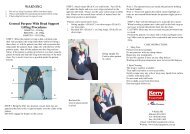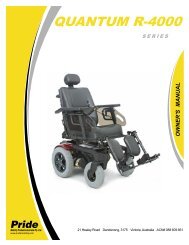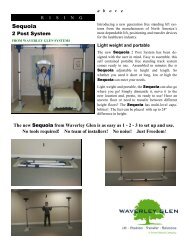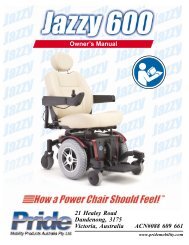User Manual Lightweight Wheelchair - Aidacare
User Manual Lightweight Wheelchair - Aidacare
User Manual Lightweight Wheelchair - Aidacare
Create successful ePaper yourself
Turn your PDF publications into a flip-book with our unique Google optimized e-Paper software.
TRANSPORTING YOUR CHAIRK•Care does not recommend that you travel in a vehicle whilst sitting in your wheelchair. Where possible, wheelchairoccupants should be transferred into a seat and use the proper vehicle seat restraints. However, if you wish your chair tobe transported in a vehicle, your vehicle wheelchair restraint system must comply with AS2942-1994.COMMON MISUSE OF MANUAL WHEELCHAIRSThere are several common misuses of wheelchairs known to K•Care that may lead to personal injury or damage to thewheelchair.• Not utilising correct lifting techniques when lifting the wheelchair.• Using the wheelchair when the pneumatic wheels are flat or only partially inflated may lead to tyre tube damage.• This wheelchair has not been designed to be used in a wet environment (shower, pool, etc). Exposure to largeamounts or long periods of moisture may lead to deterioration of the product.• Do not leave an occupant unattended in a transporter wheelchair.USE OF YOUR MANUAL WHEELCHAIRDescending/ascending steep gradientsWhen transferring either into, or out of the wheelchair, the braking mechanisms must be activated. Using the wheelchairin difficult situations such as steep gradients, side angled pathways and obstacles may be hazardous. We recommendthe following methods should be used to avoid tipping over:Picture OnePicture Two• By leaning the body forward, the stability of the wheelchair can be improved greatly when ascending a gradient (ascan be seen in Picture One).• On downward gradients, the back should be in a straight position, with the speed and direction of the wheelchaircontrolled by the user utilising the push rims, not by riding the brakes (as can be seen in Picture Two).• Under normal conditions (clean and dry surface with no side angle) it is possible to climb slopes safely of up tothirteen degrees.Crossing kerbs/obstaclesWe recommend that when accessing difficult terrain, unless you are an experienced or strong wheelchair user, that anattendant be present. The attendant can tilt the chair back using the handgrips and the rear tilt bars.When an attendant is not present, we recommend that you avoid difficult terrain and obstacles such as kerbs, by utilizingprovided walkways, wheelchair access points, etc. If these are not available and kerbs need to be accessed, carefully liftthe castors over the top of the kerb then ease the rest of the chair forward. This practice should only be attempted byexperienced and strong wheelchair users.3



